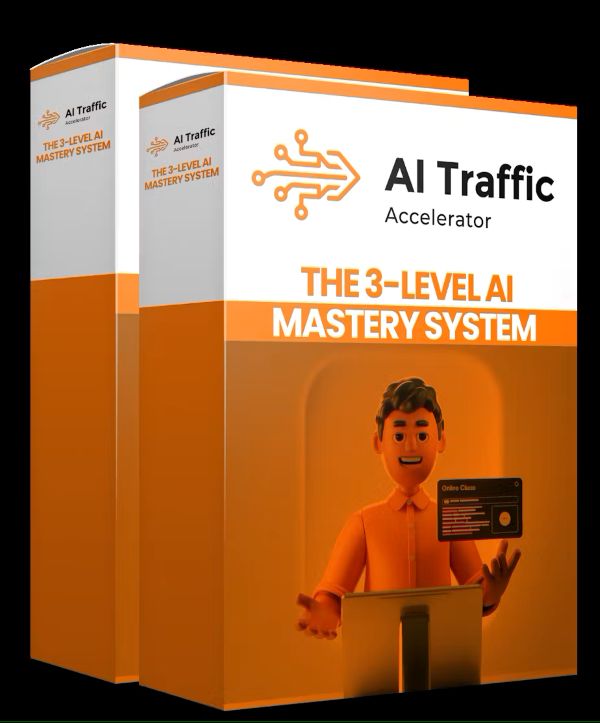No products in the cart.
[GroupBuy] AI Traffic Accelerator – Neil Napier
$29.00 $19.00
- Payment method: I will send the payment link to your email.
- Deliver by: Google Drive, Mega.nz
Category: Marketing
Discover how the AI Traffic Accelerator blueprint promises complete time freedom and hands-free growth for entrepreneurs and online marketers by leveraging a proprietary 3-Level AI Mastery system, contrasting it to traditional ineffective methods and basic AI implementations.
Table of Contents
AI Traffic Accelerator
The promise of effortless growth and complete time freedom – a siren song for any entrepreneur navigating the often-turbulent waters of online marketing. The AI Traffic Accelerator blueprint, as gleaned from its promotional materials, positions itself as the answer to these long-held desires. It paints a vivid picture: a world where traffic flows like a river, sales materialize on autopilot, and the once-demanding schedule of an online marketer transforms into a life of leisure and strategic oversight.
But is this just another shiny object in the crowded digital marketplace, or does the promise of the AI Traffic Accelerator hold genuine substance? To answer this, we must delve deeper into its core tenets, critically analyze its proposed mechanisms, and ultimately, assess its potential to deliver on its ambitious claims. This journey is about more than just exploring a specific product; it’s about understanding the evolving relationship between artificial intelligence and the future of online business.
Critique of Current AI Implementation and Traditional Marketing: The Problem the AI Traffic Accelerator Aims to Solve
The AI Traffic Accelerator doesn’t shy away from criticizing the current state of AI adoption in marketing and the perceived inadequacies of traditional methods. It presents a dichotomous world: on one side, the chaotic roller coaster of traditional online marketing, riddled with inconsistent traffic, scaling struggles, and the relentless demand for content creation yielding meager returns; on the other, the deceptive allure of AI tools, often dismissed as mere “fancy wrappers around ChatGPT” that promise the world but deliver only disappointment.
This critique resonates with many entrepreneurs who’ve dipped their toes into the AI pool, lured by the promise of effortless automation. The reality, however, often falls short. Basic AI prompting, as the blueprint suggests, can indeed lead to an “avalanche of mediocre content” – content that might be technically proficient but lacks the crucial elements of originality, engagement, and strategic alignment. Such content, while appearing productive on the surface, often fails to translate into tangible business results.
The frustration with current AI implementation stems from a fundamental misunderstanding: AI is a tool, not a magic wand. Without a clear strategy, a deep understanding of the target audience, and a well-defined business model, even the most sophisticated AI algorithms will struggle to deliver meaningful results. The AI Traffic Accelerator attempts to address this gap by offering a structured, multi-level approach to AI adoption, supposedly moving beyond the superficial application of AI tools and toward a more integrated and strategically aligned implementation.
Traditional marketing, on the other hand, is portrayed as a grueling battle against algorithm changes, content exhaustion, and the ever-present pressure to stay ahead of the curve. While the specific critiques of “feast or famine traffic cycles” and “long hours creating content for low returns” may resonate with many, it’s important to acknowledge that traditional marketing, when executed effectively, can still yield significant results. However, the AI Traffic Accelerator presents a compelling argument for those seeking a more sustainable and scalable approach, one that leverages the power of AI to automate key processes and minimize the reliance on manual labor.
The 3-Level AI Mastery Blueprint: A Deep Dive into the Proposed Solution
The heart of the AI Traffic Accelerator lies in its proprietary 3-Level AI Mastery Blueprint. This blueprint is presented as a revolutionary system designed to address the perceived shortcomings of current AI implementations and traditional marketing approaches. It promises genuine AI mastery capable of generating consistent traffic, driving sales conversions, and ultimately achieving complete business automation – “without the typical marketing grind.”
The claim that this blueprint allows for a “set it and forget it” approach, where the system generates traffic, sales, and hands-off growth for months and years to come, is undeniably enticing. However, it’s crucial to approach such promises with a healthy dose of skepticism. While automation can certainly streamline processes and reduce manual workload, it rarely eliminates the need for ongoing monitoring, optimization, and strategic adjustments. Any successful AI-powered system requires continuous learning and adaptation to remain effective in the ever-evolving digital landscape.
The fact that the blueprint supposedly took over $40,000 and a full year of trial and error to develop adds a layer of credibility. It suggests that the creators, Neil Napier and Chris Munch, invested significant resources and effort in refining the system. However, it’s important to remember that past performance is not necessarily indicative of future results. The success of the blueprint will ultimately depend on its adaptability, its ability to integrate with various business models, and its relevance in the long run.
The core idea of the blueprint – that an effective AI mastery system must progress through three distinct levels to deliver automated traffic, increased sales, and complete time freedom – is logically sound. It suggests a structured, progressive approach to AI implementation, rather than a haphazard adoption of individual tools. The devil, however, is in the details, and the effectiveness of the blueprint will depend on the specific methodologies and strategies employed at each level.
Unpacking the Three Levels of AI Mastery: Promises and Potential Pitfalls
The AI Traffic Accelerator outlines three distinct levels of AI Mastery, each designed to build upon the previous and ultimately achieve the system’s promised outcomes. Let’s examine each level in detail, considering both the potential benefits and the potential pitfalls:
- Level 1 (Basic AI Implementation): This level focuses on achieving initial results, such as booking sales calls or generating initial sales from content. The example provided, “$1,000 in new business from just one week of content,” is designed to be immediately appealing, demonstrating the potential for a quick return on investment. While achievable, this level is likely dependent on factors such as the quality of the content, the effectiveness of the sales calls, and the existing audience reach. It’s crucial to understand that Level 1 is just the foundation, and sustained success requires progression to the higher levels. More over Level 1 only provides an overview of booking sales and generating sales from the content. It is not well explained. The level needs to provide more specifics, particularly for the target audience, so that people can use it for themselves.
- Level 2 (AI Workflow Automation): This level aims to automate tasks like sales page generation, freeing up time and resources. The example of “$3,000 in automatic sales from a single page created in under 2 hours” paints a picture of effortless revenue generation. However, it’s important to consider the quality and effectiveness of the AI-generated sales page. While AI can automate the creation process, it cannot guarantee a high conversion rate. Factors such as compelling copywriting, persuasive design, and targeted messaging are still crucial for success. Moreover, a workflow and AI automation is needed to make this happen. It is hard to image the outcome with just AI to generate sales page within a short time.
- Level 3 (Multi-Agent AI Systems): Presented as the pinnacle of AI mastery, this level promises fully automated processes like lead nurturing and deal closing. The claim of “consistent $5,000+ weekly sales with virtually no human intervention” and “$60,000 in revenue in 90 days with minimal human intervention” is undoubtedly the most enticing. However, it’s also the most difficult to achieve. Building and maintaining a truly effective multi-agent AI system requires significant technical expertise, ongoing monitoring, and continuous optimization. The assumption that such a system can operate with “virtually no human intervention” is likely an over simplification. Multi-Agent AI system is an outstanding idea to generate sale lead and deal closing, but is there any safety measures if the AI agents gone wrong? I think Neil Napier need to answer this question.
The AI Traffic Accelerator’s Claims: Benefits, Urgency, and Credibility
The AI Traffic Accelerator touts a plethora of benefits for those who adopt the 3-Level system, ranging from attracting engaged visitors and experiencing steady traffic growth to achieving complete time freedom and building a “One-Person Empire” with minimal overhead. The claim that the system is “Algorithm Changes? No Problem” due to a multi-channel approach is particularly appealing, suggesting a robust and resilient system capable of withstanding the constant fluctuations of the online landscape.
However, it’s important to approach these claims with a critical eye. While a well-designed multi-channel strategy can certainly mitigate the impact of algorithm changes, it’s unlikely to render the system completely immune. Furthermore, the idea of a “Zero Technical Complexity” solution requiring “No coding required” may be misleading. While the blueprint may be designed for beginners, a certain level of technical understanding and problem-solving skills will likely be necessary to successfully implement and maintain the system.
The emphasis on urgency and the “early adopter advantage” is a common marketing tactic designed to encourage immediate action. While there may be genuine benefits to being an early adopter, it’s crucial to avoid making hasty decisions based on fear of missing out. Thorough research, careful consideration of one’s own business needs, and a realistic assessment of the potential risks and rewards are essential before committing to any new system or program.
The credibility of Neil Napier and Chris Munch, the presenters of the AI Traffic Accelerator, is bolstered by their claims of extensive experience, significant investment, and proven results. Their ability to distinguish themselves from “Overnight AI Millionaires and AI Gurus” by emphasizing their longevity and validated expertise adds a layer of trust. However, it’s important to independently verify their claims and assess their track record before making any investment.
Neil Napier
Neil Napier, along with Chris Munch, stands as the face and the driving force behind the AI Traffic Accelerator. Their positioning as seasoned entrepreneurs who have “fully embraced AI in our businesses with remarkable results” is central to the program’s appeal. Understanding their background, expertise, and the credibility they bring to the table is crucial for anyone considering investing in the AI Traffic Accelerator. Are they genuinely experienced marketers with a track record of success, or are they simply jumping on the AI bandwagon with promises that sound too good to be true? The answers to these questions will significantly influence the perceived value and the overall trustworthiness of the entire system.
Evaluating Neil Napier’s Background and Expertise: Beyond the Sales Pitch
To assess the credibility of Neil Napier, it’s essential to look beyond the promotional materials and delve into his background and expertise. This involves examining his previous ventures, his track record of success in the online marketing space, and his overall reputation within the industry. Has he consistently delivered results for his clients or customers? Does he possess a deep understanding of the underlying principles of AI and marketing? These are crucial questions to consider.
Claims of “fully embracing AI” and building entire business models around it should be supported by tangible evidence. Has Neil Napier publicly shared case studies, testimonials, or concrete examples of his AI-driven successes? Is he transparent about the methodologies and strategies he employs? A lack of transparency or a reliance on vague generalizations should raise a red flag. It’s important to remember that the online marketing landscape is rife with individuals who make unsubstantiated claims, and a healthy dose of skepticism is always warranted.
Furthermore, it’s worth investigating Neil Napier‘s involvement in the broader AI community. Does he contribute to open-source projects, participate in industry conferences, or engage in thought leadership activities? A genuine passion for AI and a commitment to sharing knowledge are often indicative of a deeper understanding and a more credible approach. Neil Napier should focus on marketing with proven data.
The Importance of Transparency and Verifiable Results
In an era of increasing skepticism and information overload, transparency is paramount. Claims of achieving remarkable results with AI should be backed by verifiable data, not just anecdotal evidence. This could include metrics such as website traffic, conversion rates, sales figures, and customer satisfaction scores. The more specific and detailed the data, the more credible the claims become.
While testimonials can be valuable, they should be viewed with caution. It’s important to ensure that testimonials are genuine and not fabricated or coerced. Look for testimonials from reputable sources or individuals who are willing to publicly endorse the product or service. Furthermore, consider the context in which the testimonials were provided. Were the individuals compensated for their testimonials? Were they given any special treatment or incentives?
Ultimately, the best way to assess the validity of claims is to conduct independent research and gather feedback from other users. Search for reviews and opinions on online forums, social media platforms, and industry websites. Pay attention to both positive and negative feedback, and look for patterns or recurring themes. A balanced perspective is essential for making an informed decision. More over, Neil Napier must work independently and not copy or use any data that has been already created by marketing agencies
Discriminating Between Genuine Expertise and AI Hype: The Role of Critical Thinking
The online marketing world is awash with AI hype, and it can be difficult to distinguish between genuine expertise and empty promises. Critical thinking is essential for navigating this complex landscape and making informed decisions. This involves questioning assumptions, evaluating evidence, and considering alternative perspectives.
One of the key skills of a critical thinker is the ability to identify logical fallacies and biases. Be wary of arguments that rely on emotional appeals, anecdotal evidence, or appeals to authority. Look for evidence-based arguments that are supported by data and logical reasoning. Furthermore, be aware of your own biases and assumptions, and strive to approach the information with an open mind.
Distinguishing between genuine expertise and AI hype also requires a deep understanding of the underlying principles of AI and marketing. Take the time to educate yourself on these topics, and don’t be afraid to ask questions. The more you understand about AI and marketing, the better equipped you will be to evaluate the claims made by Neil Napier and other AI marketers. He should be more open for accepting question from users.
Ultimately, the decision of whether or not to invest in the AI Traffic Accelerator is a personal one. It should be based on your own research, your own assessment of the risks and rewards, and your own understanding of your business needs. Don’t be swayed by hype or pressure tactics. Take your time to make an informed decision that is right for you. The AI traffic accelerator seems legit, but customers needs to check every data whether or not its true.
Conclusion
In conclusion, the AI Traffic Accelerator presents a compelling vision of automated growth through its proprietary 3-Level AI Mastery Blueprint. While the promises of complete time freedom and hands-free business operations are enticing, it’s crucial to approach the program with a critical and informed perspective. The critique of current AI implementation and traditional marketing resonates with many, but the effectiveness of the blueprint hinges on its ability to deliver on its ambitious claims. Independent research into Neil Napier‘s background, coupled with a healthy dose of skepticism towards the “early adopter advantage” urgency, is essential before making any investment. Only through diligent evaluation and a realistic assessment of one’s own business needs can entrepreneurs determine whether the promises of the AI Traffic Accelerator are grounded in reality or simply the latest iteration of online marketing hype.
Sales Page:_https://aitrafficaccelerator.com/effortless
Delivery time: 12 -24hrs after paid
Be the first to review “[GroupBuy] AI Traffic Accelerator – Neil Napier” Cancel reply
Related products
Sale!
$39.00
Marketing
$19.00
Sale!











Reviews
There are no reviews yet.